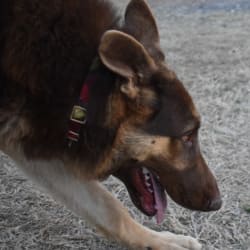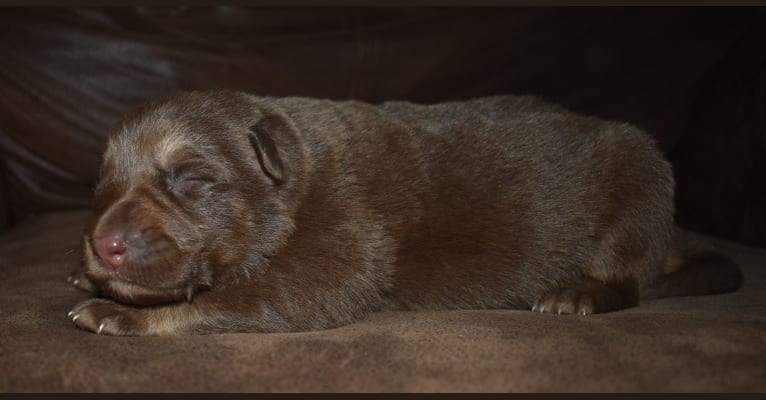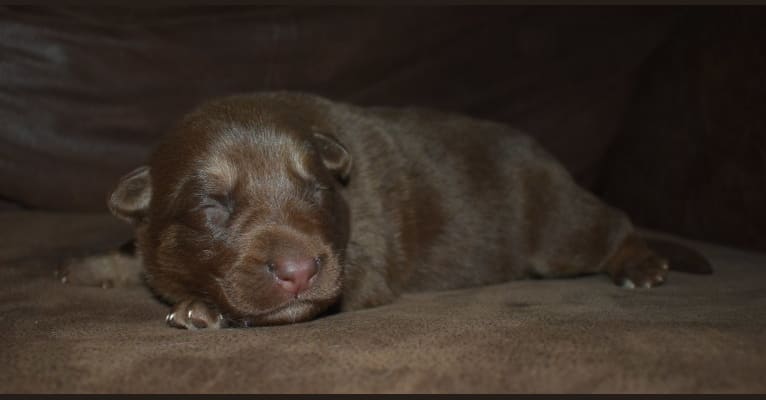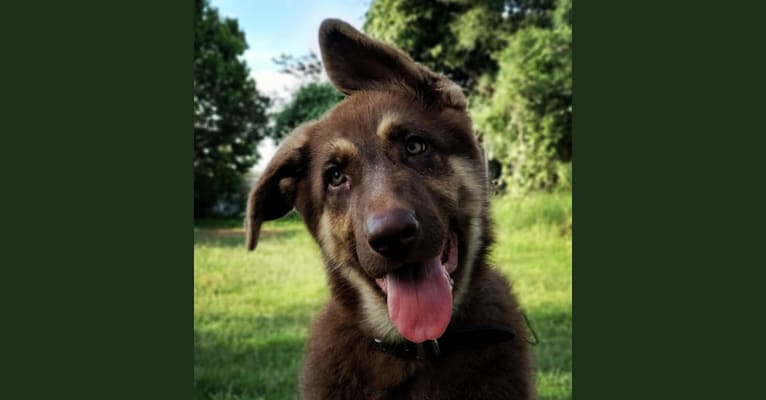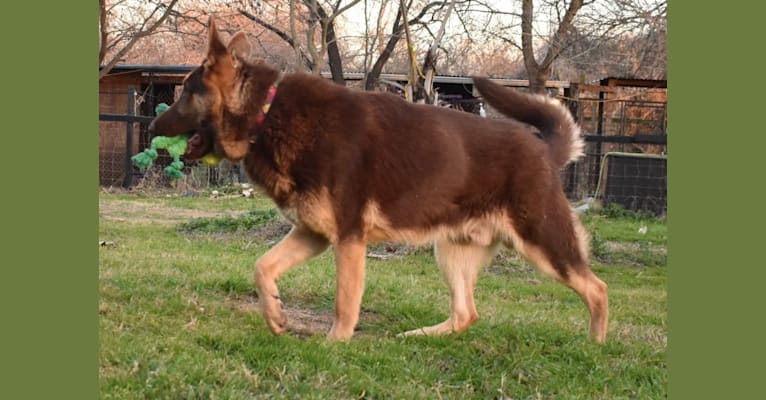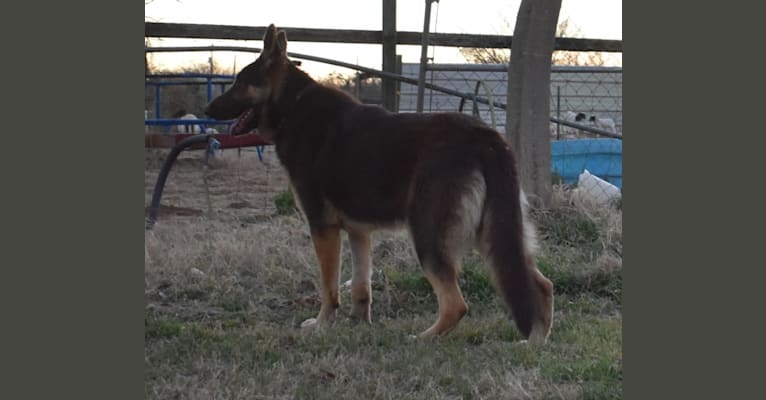Bell's whiskey bear von Wolfgang haus inherited one copy of the variant we tested
No bio has been provided yet
This dog has been viewed and been given 0 wags
Genetic Breed Result
Bell's whiskey bear von W…
German Shepherd Dog
100.0% German Shepherd Dog

German Shepherd Dog
German Shepherds are confident, courageous dogs with a keen sense of smell and notable intelligence. These are active working dogs who excel at many canine sports and tasks -- they are true utility dogs! Their versatility combined with their loyal companionship has them consistently listed as one of the most popular breeds in the United States.
Learn More
Dig into your dog’s mix
From energy to appetite, from herding to health — it’s amazing how much you can learn about your dog with just a cheek swab. What will you find out?
Get your test
Start a conversation! Message this dog’s owner.
Genetic stats
Explore
Changes to this dog’s profile
- On 6/25/2021 changed name from "Bella liver boy" to "Bell's whiskey bear von Wolfgang haus"
- On 3/24/2021 changed name from "Coco liver boy" to "Bella liver boy"
Our policy is that each dog’s profile should accurately portray the dog to which the genetic reports belong.
To help ensure adherence to this policy, we show here any changes that have been made to the name or handle (web address) of this dog.
If you believe that this profile is in violation of this policy, you may contact us to report it.
Health Summary
Bell's whiskey bear von Wolfgang haus has one variant that you should let your vet know about.
ALT Activity
Why is this important to your vet?
Bell's whiskey bear von Wolfgang haus has one copy of a variant associated with reduced ALT activity as measured on veterinary blood chemistry panels. Please inform your veterinarian that Bell's whiskey bear von Wolfgang haus has this genotype, as ALT is often used as an indicator of liver health and Bell's whiskey bear von Wolfgang haus is likely to have a lower than average resting ALT activity. As such, an increase in Bell's whiskey bear von Wolfgang haus’s ALT activity could be evidence of liver damage, even if it is within normal limits by standard ALT reference ranges.
What is ALT Activity?
Alanine aminotransferase (ALT) is a clinical tool that can be used by veterinarians to better monitor liver health. This result is not associated with liver disease. ALT is one of several values veterinarians measure on routine blood work to evaluate the liver. It is a naturally occurring enzyme located in liver cells that helps break down protein. When the liver is damaged or inflamed, ALT is released into the bloodstream.
Breed-Relevant Genetic Conditions
Multiple Drug Sensitivity (ABCB1)
Identified in German Shepherd Dogs
Variant not detected
Hemophilia A (F8 Exon 11, German Shepherd Variant 1)
Identified in German Shepherd Dogs
Variant not detected
Hemophilia A (F8 Exon 1, German Shepherd Variant 2)
Identified in German Shepherd Dogs
Variant not detected
Canine Leukocyte Adhesion Deficiency Type III, CLAD III (FERMT3, German Shepherd Variant)
Identified in German Shepherd Dogs
Variant not detected
Platelet Factor X Receptor Deficiency, Scott Syndrome (TMEM16F)
Identified in German Shepherd Dogs
Variant not detected
Day Blindness (CNGA3 Exon 7, German Shepherd Variant)
Identified in German Shepherd Dogs
Variant not detected
Urate Kidney & Bladder Stones (SLC2A9)
Identified in German Shepherd Dogs
Variant not detected
Anhidrotic Ectodermal Dysplasia (EDA Intron 8)
Identified in German Shepherd Dogs
Variant not detected
Renal Cystadenocarcinoma and Nodular Dermatofibrosis (FLCN Exon 7)
Identified in German Shepherd Dogs
Variant not detected
Mucopolysaccharidosis Type VII, Sly Syndrome, MPS VII (GUSB Exon 3, German Shepherd Variant)
Identified in German Shepherd Dogs
Variant not detected
Degenerative Myelopathy, DM (SOD1A)
Identified in German Shepherd Dogs
Variant not detected
Additional Genetic Conditions
Explore
Traits
Explore the genetics behind your dog’s appearance and size.

Coat Color
The E Locus determines if and where a dog can produce dark (black or brown) hair. Dogs with two copies of the recessive e variant do not produce dark hairs and will express a red pigment called pheomelanin over their entire body. The shade of red, which can range from a deep copper to white, depends on other genetic factors, including the Intensity loci. In addition to determining if a dog can develop dark hairs, the E Locus can give a dog a black “mask” or “widow’s peak” unless the dog has overriding coat color genetic factors.
Dogs with one or two copies of the Em variant may have a melanistic mask (dark facial hair as commonly seen in the German Shepherd Dog and Pug). In the absence of Em, dogs with the Eg variant can have a “grizzle” phenotype (darker color on the head and top with a melanistic "widow's peak" and a lighter underside, commonly seen in the Afghan Hound and Borzoi and also referred to as “domino”). In the absence of both Em and E variants, dogs with the Ea or Eh variants can express the grizzle phenotype. Additionally, a dog with any combination of two of the Eg, Ea, or Eh variants (example: EgEa) is also expected to express the grizzle phenotype.
More information: http://www.doggenetics.co.uk/masks.html
The K Locus KB allele “overrides” the A Locus, meaning that it prevents the A Locus genotype from affecting coat color. For this reason, the KB allele is referred to as the “dominant black” allele. As a result, dogs with at least one KB allele will usually have solid black or brown coats (or red/cream coats if they are ee at the E Locus) regardless of their genotype at the A Locus, although several other genes could impact the dog’s coat and cause other patterns, such as white spotting. Dogs with the kyky genotype will show a coat color pattern based on the genotype they have at the A Locus. Dogs who test as KBky may be brindle rather than black or brown.
More information: http://www.doggenetics.co.uk/black.htm
Areas of a dog's coat where dark (black or brown) pigment is not expressed either contain red/yellow pigment, or no pigment at all. Five locations across five chromosomes explain approximately 70% of red pigmentation "intensity" variation across all dogs. Dogs with a result of Intense Red Pigmentation will likely have deep red hair like an Irish Setter or "apricot" hair like some Poodles, dogs with a result of Intermediate Red Pigmentation will likely have tan or yellow hair like a Soft-Coated Wheaten Terrier, and dogs with Dilute Red Pigmentation will likely have cream or white hair like a Samoyed. Because the mutations we test may not directly cause differences in red pigmentation intensity, we consider this to be a linkage test.
The A Locus controls switching between black and red pigment in hair cells, but it will only be expressed in dogs that are not ee at the E Locus and are kyky at the K Locus. Sable (also called “Fawn”) dogs have a mostly or entirely red coat with some interspersed black hairs. Agouti (also called “Wolf Sable”) dogs have red hairs with black tips, mostly on their head and back. Black and tan dogs are mostly black or brown with lighter patches on their cheeks, eyebrows, chest, and legs. Recessive black dogs have solid-colored black or brown coats.
More information: http://www.doggenetics.co.uk/tan.html
The D locus result that we report is determined by three different genetic variants that can work together to cause diluted pigmentation. These are the common d allele, also known as “d1”, and the less common alleles known as “d2” and “d3”. Dogs with two d alleles, regardless of which variant, will have all black pigment lightened (“diluted”) to gray, or brown pigment lightened to lighter brown in their hair, skin, and sometimes eyes. There are many breed-specific names for these dilute colors, such as “blue”, “charcoal”, “fawn”, “silver”, and “Isabella”. Note that in certain breeds, dilute dogs have a higher incidence of Color Dilution Alopecia. Dogs with one d allele will not be dilute, but can pass the d allele on to their puppies.
More information: http://www.doggenetics.co.uk/dilutes.html
Dogs with the coco genotype will produce dark brown pigment instead of black in both their hair and skin. Dogs with the Nco genotype will produce black pigment, but can pass the co allele on to their puppies. Dogs that have the coco genotype as well as the bb genotype at the B locus are generally a lighter brown than dogs that have the Bb or BB genotypes at the B locus.
More information: http://www.doggenetics.co.uk/liver.html#cocoa
Dogs with two copies of the b allele produce brown pigment instead of black in both their hair and skin. Dogs with one copy of the b allele will produce black pigment, but can pass the b allele on to their puppies. E Locus ee dogs that carry two b alleles will have red or cream coats, but have brown noses, eye rims, and footpads (sometimes referred to as "Dudley Nose" in Labrador Retrievers). “Liver” or “chocolate” is the preferred color term for brown in most breeds; in the Doberman Pinscher it is referred to as “red”.
More information: http://www.doggenetics.co.uk/liver.html
The "Saddle Tan" pattern causes the black hairs to recede into a "saddle" shape on the back, leaving a tan face, legs, and belly, as a dog ages. The Saddle Tan pattern is characteristic of breeds like the Corgi, Beagle, and German Shepherd. Dogs that have the II genotype at this locus are more likely to be mostly black with tan points on the eyebrows, muzzle, and legs as commonly seen in the Doberman Pinscher and the Rottweiler. This gene modifies the A Locus at allele, so dogs that do not express at are not influenced by this gene.
The S Locus determines white spotting and pigment distribution. MITF controls where pigment is produced, and an insertion in the MITF gene causes a loss of pigment in the coat and skin, resulting in white hair and/or pink skin. Dogs with two copies of this variant will likely have breed-dependent white patterning, with a nearly white, parti, or piebald coat. Dogs with one copy of this variant will have more limited white spotting and may be considered flash, parti or piebald. This MITF variant does not explain all white spotting patterns in dogs and other variants are currently being researched. Some dogs may have small amounts of white on the paws, chest, face, or tail regardless of their S Locus genotype.
More information: http://www.doggenetics.co.uk/white.htm
Merle coat patterning is common to several dog breeds including the Australian Shepherd, Catahoula Leopard Dog, and Shetland Sheepdog, among many others. Merle arises from an unstable SINE insertion (which we term the "M*" allele) that disrupts activity of the pigmentary gene PMEL, leading to mottled or patchy coat color. Dogs with an M*m result are likely to be phenotypically merle or could be "non-expressing" merle, meaning that the merle pattern is very subtle or not at all evident in their coat. Dogs with an M*M* result are likely to be phenotypically merle or double merle. Dogs with an mm result have no merle alleles and are unlikely to have a merle coat pattern.
Note that Embark does not currently distinguish between the recently described cryptic, atypical, atypical+, classic, and harlequin merle alleles. Our merle test only detects the presence, but not the length of the SINE insertion. We do not recommend making breeding decisions on this result alone. Please pursue further testing for allelic distinction prior to breeding decisions.
More information: http://www.doggenetics.co.uk/merle.html
The R Locus regulates the presence or absence of the roan coat color pattern. Partial duplication of the USH2A gene is strongly associated with this coat pattern. Dogs with at least one R allele will likely have roaning on otherwise uniformly unpigmented white areas. Roan appears in white areas controlled by the S Locus but not in other white or cream areas created by other loci, such as the E Locus with ee along with Dilute Red Pigmentation by I Locus (for example, in Samoyeds). Mechanisms for controlling the extent of roaning are currently unknown, and roaning can appear in a uniform or non-uniform pattern. Further, non-uniform roaning may appear as ticked, and not obviously roan. The roan pattern can appear with or without ticking.
More information: http://www.doggenetics.co.uk/ticking.html
This pattern is recognized in Great Danes and causes dogs to have a white coat with patches of darker pigment. A dog with an Hh result will be harlequin if they are also M*m or M*M* at the M Locus and are not ee at the E locus. Dogs with a result of hh will not be harlequin. This trait is thought to be homozygous lethal; a living dog with an HH genotype has never been found.
More information: http://www.doggenetics.co.uk/harlequin.html

Other Coat Traits
Dogs with one or two copies of the F allele have “furnishings”: the mustache, beard, and eyebrows characteristic of breeds like the Schnauzer, Scottish Terrier, and Wire Haired Dachshund. A dog with two I alleles will not have furnishings, which is sometimes called an “improper coat” in breeds where furnishings are part of the breed standard. The mutation is a genetic insertion which we measure indirectly using a linkage test highly correlated with the insertion.
The FGF5 gene affects hair length in many species, including cats, dogs, mice, and humans. In dogs, an Lh allele confers a long, silky hair coat across many breeds, including Yorkshire Terriers, Cocker Spaniels, and Golden Retrievers, while the Sh allele causes a shorter coat, as seen in the Boxer or the American Staffordshire Terrier. In certain breeds, such as the Pembroke Welsh Corgi and French Bulldog, the long haircoat is described as “fluffy”. The coat length determined by FGF5, as reported by us, is influenced by four genetic variants that work together to promote long hair.
The most common of these is the Lh1 variant (G/T, CanFam3.1, chr32, g.4509367) and the less common ones are Lh2 (C/T, CanFam3.1, chr32, g.4528639), Lh3 (16bp deletion, CanFam3.1, chr32, g.4528616), and Lh4 (GG insertion, CanFam3.1, chr32, g.4528621). The FGF5_Lh1 variant is found across many dog breeds. The less common alleles, FGF5_Lh2, have been found in the Akita, Samoyed, and Siberian Husky, FGF5_Lh3 have been found in the Eurasier, and FGF5_Lh4 have been found in the Afghan Hound, Eurasier, and French Bulldog.
The Lh alleles have a recessive mode of inheritance, meaning that two copies of the Lh alleles are required to have long hair. The presence of two Lh alleles at any of these FGF5 loci is expected to result in long hair. One copy each of Lh1 and Lh2 have been found in Samoyeds, one copy each of Lh1 and Lh3 have been found in Eurasiers, and one copy each of Lh1 and Lh4 have been found in the Afghan Hounds and Eurasiers.
Interestingly, the Lh3 variant, a 16 base pair deletion, encompasses the Lh4 variant (GG insertion). The presence of one or two copies of Lh3 influences the outcome at the Lh4 locus. When two copies of Lh3 are present, there will be no reportable result for the FGF5_Lh4 locus. With one copy of Lh3, Lh4 can have either one copy of the variant allele or the normal allele. The overall FGF5 result remains unaffected by this.
Dogs with at least one copy of the ancestral C allele, like many Labradors and German Shepherd Dogs, are heavy or seasonal shedders, while those with two copies of the T allele, including many Boxers, Shih Tzus and Chihuahuas, tend to be lighter shedders. Dogs with furnished/wire-haired coats caused by RSPO2 (the furnishings gene) tend to be low shedders regardless of their genotype at this gene.
Dogs with a long coat and at least one copy of the T allele have a wavy or curly coat characteristic of Poodles and Bichon Frises. Dogs with two copies of the ancestral C allele are likely to have a straight coat, but there are other factors that can cause a curly coat, for example if they at least one F allele for the Furnishings (RSPO2) gene then they are likely to have a curly coat. Dogs with short coats may carry one or two copies of the T allele but still have straight coats.
A duplication in the FOXI3 gene causes hairlessness over most of the body as well as changes in tooth shape and number. This mutation occurs in Peruvian Inca Orchid, Xoloitzcuintli (Mexican Hairless), and Chinese Crested (other hairless breeds have different mutations). Dogs with the NDup genotype are likely to be hairless while dogs with the NN genotype are likely to have a normal coat. The DupDup genotype has never been observed, suggesting that dogs with that genotype cannot survive to birth. Please note that this is a linkage test, so it may not be as predictive as direct tests of the mutation in some lines.
Hairlessness in the American Hairless Terrier arises from a mutation in the SGK3 gene. Dogs with the DD result are likely to be hairless. Dogs with the ND genotype will have a normal coat, but can pass the D variant on to their offspring.
Dogs with two copies DD of this deletion in the SLC45A2 gene have oculocutaneous albinism (OCA), also known as Doberman Z Factor Albinism, a recessive condition characterized by severely reduced or absent pigment in the eyes, skin, and hair. Affected dogs sometimes suffer from vision problems due to lack of eye pigment (which helps direct and absorb ambient light) and are prone to sunburn. Dogs with a single copy of the deletion ND will not be affected but can pass the mutation on to their offspring. This particular mutation can be traced back to a single white Doberman Pinscher born in 1976, and it has only been observed in dogs descended from this individual. Please note that this is a linkage test, so it may not be as predictive as direct tests of the mutation in some lines.

Other Body Features
Dogs in medium-length muzzle (mesocephalic) breeds like Staffordshire Terriers and Labradors, and long muzzle (dolichocephalic) breeds like Whippet and Collie have one, or more commonly two, copies of the ancestral C allele. Dogs in many short-length muzzle (brachycephalic) breeds such as the English Bulldog, Pug, and Pekingese have two copies of the derived A allele. At least five different genes affect muzzle length in dogs, with BMP3 being the only one with a known causal mutation. For example, the skull shape of some breeds, including the dolichocephalic Scottish Terrier or the brachycephalic Japanese Chin, appear to be caused by other genes. Thus, dogs may have short or long muzzles due to other genetic factors that are not yet known to science.
Whereas most dogs have two C alleles and a long tail, dogs with one G allele are likely to have a bobtail, which is an unusually short or absent tail. This mutation causes natural bobtail in many breeds including the Pembroke Welsh Corgi, the Australian Shepherd, and the Brittany Spaniel. Dogs with GG genotypes have not been observed, suggesting that dogs with the GG genotype do not survive to birth.
Please note that this mutation does not explain every natural bobtail! While certain lineages of Boston Terrier, English Bulldog, Rottweiler, Miniature Schnauzer, Cavalier King Charles Spaniel, and Parson Russell Terrier, and Dobermans are born with a natural bobtail, these breeds do not have this mutation. This suggests that other unknown genetic mutations can also lead to a natural bobtail.
Common in certain breeds such as the Saint Bernard, hind dewclaws are extra, nonfunctional digits located midway between a dog's paw and hock. Dogs with at least one copy of the T allele have about a 50% chance of having hind dewclaws. Note that other (currently unknown to science) mutations can also cause hind dewclaws, so some CC or TC dogs will have hind dewclaws.
Embark researchers discovered this large duplication associated with blue eyes in Arctic breeds like Siberian Husky as well as tri-colored (non-merle) Australian Shepherds. Dogs with at least one copy of the duplication (Dup) are more likely to have at least one blue eye. Some dogs with the duplication may have only one blue eye (complete heterochromia) or may not have blue eyes at all; nevertheless, they can still pass the duplication and the trait to their offspring. NN dogs do not carry this duplication, but may have blue eyes due to other factors, such as merle. Please note that this is a linkage test, so it may not be as predictive as direct tests of the mutation in some lines.
The T allele is associated with heavy muscling along the back and trunk in characteristically "bulky" large-breed dogs including the Saint Bernard, Bernese Mountain Dog, Greater Swiss Mountain Dog, and Rottweiler. The “bulky” T allele is absent from leaner shaped large breed dogs like the Great Dane, Irish Wolfhound, and Scottish Deerhound, which are fixed for the ancestral C allele. Note that this mutation does not seem to affect muscling in small or even mid-sized dog breeds with notable back muscling, including the American Staffordshire Terrier, Boston Terrier, and the English Bulldog.

Body Size
The I allele is associated with smaller body size.
The A allele is associated with smaller body size.
The A allele is associated with smaller body size.
The A allele is associated with smaller body size.
The T allele is associated with smaller body size.

Performance
This mutation causes dogs to be especially tolerant of low oxygen environments (hypoxia), such as those found at high elevations. Dogs with at least one A allele are less susceptible to "altitude sickness." This mutation was originally identified in breeds from high altitude areas such as the Tibetan Mastiff.
This mutation in the POMC gene is found primarily in Labrador and Flat Coated Retrievers. Compared to dogs with no copies of the mutation (NN), dogs with one (ND) or two (DD) copies of the mutation are more likely to have high food motivation, which can cause them to eat excessively, have higher body fat percentage, and be more prone to obesity. Read more about the genetics of POMC, and learn how you can contribute to research, in our blog post. We measure this result using a linkage test.
Dig into your dog’s mix
From energy to appetite, from herding to health — it’s amazing how much you can learn about your dog with just a cheek swab. What will you find out?
Get your test
Explore
Through Bell's whiskey bear von Wolfgang haus’s mitochondrial DNA we can trace his mother’s ancestry back to where dogs and people first became friends. This map helps you visualize the routes that his ancestors took to your home. Their story is described below the map.
B1
B95

B1
B1 is the second most common maternal lineage in breeds of European or American origin. It is the female line of the majority of Golden Retrievers, Basset Hounds, and Shih Tzus, and about half of Beagles, Pekingese and Toy Poodles. This lineage is also somewhat common among village dogs that carry distinct ancestry from these breeds. We know this is a result of B1 dogs being common amongst the European dogs that their conquering owners brought around the world, because nowhere on earth is it a very common lineage in village dogs. It even enables us to trace the path of (human) colonization: Because most Bichons are B1 and Bichons are popular in Spanish culture, B1 is now fairly common among village dogs in Latin America.
B95
Part of the B1 haplogroup, we see this haplotype most frequently in mixed breed dogs.

The B1 haplogroup can be found in village dogs like the Peruvian Village Dog, pictured above.
Dig into your dog’s mix
From energy to appetite, from herding to health — it’s amazing how much you can learn about your dog with just a cheek swab. What will you find out?
Get your test
Explore
Through Bell's whiskey bear von Wolfgang haus’s Y-chromosome we can trace his father’s ancestry back to where dogs and people first became friends. This map helps you visualize the routes that his ancestors took to your home. Their story is described below the map.
A1a
H1a.15

A1a
Some of the wolves that became the original dogs in Central Asia around 15,000 years ago came from this long and distinguished line of male dogs. After domestication, they followed their humans from Asia to Europe and then didn't stop there. They took root in Europe, eventually becoming the dogs that founded the Vizsla breed 1,000 years ago. The Vizsla is a Central European hunting dog, and all male Vizslas descend from this line. During the Age of Exploration, like their owners, these pooches went by the philosophy, "Have sail, will travel!" From the windy plains of Patagonia to the snug and homey towns of the American Midwest, the beaches of a Pacific paradise, and the broad expanse of the Australian outback, these dogs followed their masters to the outposts of empires. Whether through good fortune or superior genetics, dogs from the A1a lineage traveled the globe and took root across the world. Now you find village dogs from this line frolicking on Polynesian beaches, hanging out in villages across the Americas, and scavenging throughout Old World settlements. You can also find this "prince of patrilineages" in breeds as different as German Shepherds, Golden Retrievers, Pugs, Border Collies, Scottish Terriers, and Irish Wolfhounds. No male wolf line has been as successful as the A1a line!
H1a.15
Part of the large A1a haplogroup, this haplotype is found in village dogs from across the globe (outside of Asia). As for breeds, it is primarily seen in German Shepherds, Labrador Retrievers, Nova Scotia Duck Tolling Retriever. It is by far the most common haplotype in German Shepherds.

Dogs with A1a lineage travelled during European Colonial times.
Dig into your dog’s mix
From energy to appetite, from herding to health — it’s amazing how much you can learn about your dog with just a cheek swab. What will you find out?
Get your test
